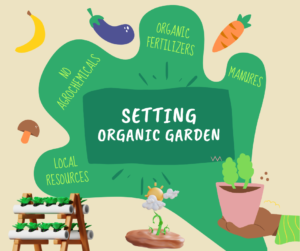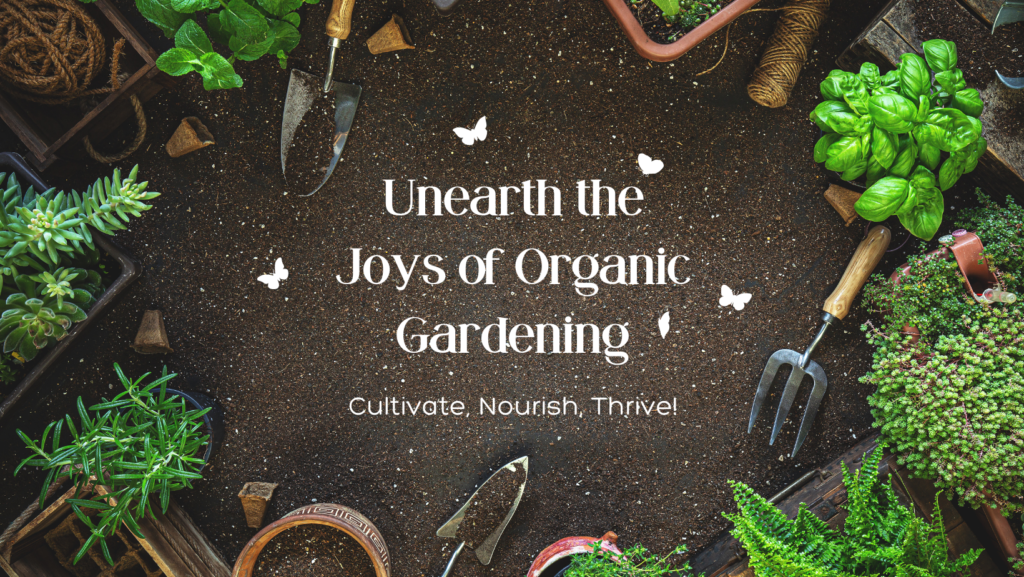Introduction
Welcome to the world of organic gardening, where your green thumb meets Mother Nature in perfect harmony! Whether you’re a city dweller with a small balcony or a homeowner with ample backyard space, this guide is your gateway to starting your very own organic garden. Let’s embark on a journey to cultivate a healthier, more sustainable lifestyle right in your backyard or living room.
Understanding Organic Gardening
Starting a Green Adventure: The Essence of Organic Gardening
Welcome, aspiring gardeners and nature enthusiasts! Are you ready to delve into the enriching world of organic gardening? This journey is not just about growing plants; it’s about nurturing a deeper connection with nature and embracing a more sustainable lifestyle. In this opening section, we’ll explore what organic gardening truly entails, its myriad benefits, and the positive environmental impact it fosters.
What is Organic Gardening?
Organic gardening is a holistic approach to cultivating plants that focuses on natural processes and materials. It’s about growing fruits, vegetables, and flowers without synthetic fertilizers, pesticides, or genetically modified organisms (GMOs). Instead, organic gardening relies on compost, natural plant food, and biological pest control to create a harmonious, productive garden ecosystem.
The Benefits of Organic Gardening
The advantages of organic gardening extend far beyond the yield of your garden. Here are some key benefits:
- Healthier Produce: Organic gardening produces fruits and vegetables free from harmful chemicals, making them healthier for consumption.
- Enhanced Biodiversity: By avoiding synthetic chemicals, organic gardens become a haven for beneficial insects, birds, and other wildlife, enhancing local biodiversity.
- Soil Health: Organic practices improve soil structure and fertility over time, leading to more robust and resilient plant growth.
Environmental Impact of Organic Practices
Organic gardening is more than a personal choice; it’s a contribution to environmental sustainability. According to the Rodale Institute, organic farming practices can reduce carbon dioxide and help combat climate change. Organic soil management techniques, such as composting and mulching, increase soil organic matter, leading to better carbon sequestration.
Additionally, organic gardens play a crucial role in water conservation and quality. By avoiding synthetic fertilizers and pesticides, organic gardening prevents these chemicals from running off into waterways, thus protecting aquatic ecosystems and reducing water pollution.
Organic Gardening: A Step Towards a Greener Future
Moving further to our organic gardening journey, it’s clear that this practice is not just about what we grow, but how we grow it. Organic gardening represents a commitment to nurturing the earth and preserving its resources for future generations. It’s a step towards a more sustainable and environmentally conscious way of living.
Stay tuned as we dive deeper into the world of organic gardening, uncovering the secrets to creating a thriving, eco-friendly garden. Whether you’re a seasoned gardener or just starting, this guide will provide you with the knowledge and inspiration you need to grow sustainably.

Setting Up Your Organic Garden
Laying the Foundations: The First Steps in Organic Gardening
Greetings, green-thumbed pioneers! As we delve into the practical aspects of organic gardening, it’s crucial to start with the basics: setting up your garden. This involves choosing the right location, understanding soil types, preparing organic top soil, and selecting the right seeds and plants. Let’s navigate these foundational steps to ensure your organic garden flourishes from the ground up.
Choosing the Right Location
The location of your garden significantly influences its success. Ideally, choose a spot that receives ample sunlight – around 6 to 8 hours a day – as most vegetables and fruits thrive in full sun. Also, consider accessibility to water and protection from strong winds. If space is limited, don’t fret! Container gardening can be an excellent alternative for balconies or patios.
Understanding Soil Types
Soil is the lifeblood of your garden. Different soil types – sandy, clay, silt, and loam – each have unique characteristics and nutrient profiles. Conduct a soil test (kits available at Gardeners) to determine your soil type and its pH level. This information is crucial for amending and preparing your soil effectively.
Preparing Organic Top Soil
Creating rich, organic top soil is essential for a thriving garden. Start by adding organic matter like compost, aged manure, or leaf mold. These additions improve soil structure, provide essential nutrients, and enhance soil fertility. Products like Miracle-Gro Organic Choice Garden Soil can also be mixed into your native soil to enrich it further.
Selecting Organic Seeds and Plants
Choosing the right seeds and plants is the next critical step. Opt for organic seeds, which are free from synthetic chemicals and GMOs. These seeds are adapted to grow in organic conditions and are often more resilient to pests and diseases. For a wide variety of organic seeds, check out Seed Savers Exchange.
When selecting plants, consider your local climate and the specific needs of each plant. Local nurseries often provide a great selection of organic plants suited to your region.
Top Organic Top Soil Brands
For gardeners looking to buy top-quality organic top soil, brands like FoxFarm and Dr. Earth offer excellent options. These products are formulated to provide the ideal growing environment for your organic garden.
With these foundational steps in place, you’re well on your way to creating a successful organic garden. Remember, the key to organic gardening is working with nature, not against it. By understanding and respecting the natural processes, you can create a flourishing garden that’s both productive and sustainable.
Indoor Organic Gardening Essentials
Cultivating Your Green Haven Indoors: A Guide to Indoor Organic Gardening
Hello, urban gardeners and space-savvy plant enthusiasts! Ready to bring the joys of gardening indoors? Indoor organic gardening is a fantastic way to grow your own greens, regardless of the outdoor space available. In this section, we’ll guide you through setting up an indoor garden system tailored to different spaces, selecting the best plants for indoor cultivation, and understanding the importance of indoor plant fertilizer.
Setting Up Indoor Gardens: Space-Specific Tips
- Small Spaces: For those with limited space, such as apartment dwellers, vertical gardens or hanging planters are ideal. Utilize wall space or windowsills with products like Gardener’s Supply Company’s Vertical Planters. Herbs, small leafy greens, and dwarf varieties of vegetables are perfect for these setups.
- Medium Spaces: If you have a bit more room, like a balcony or a dedicated corner, consider using larger containers or tiered plant stands. Self-watering planters can be a great addition, providing consistent moisture essential for indoor plants.
- Large Spaces: For those with ample indoor space, such as a sunroom, you can create a more extensive indoor garden with a mix of free-standing pots and larger planters. Incorporating a small greenhouse or grow tent can create an ideal environment for a wider variety of plants.
Choosing the Best Plants for Indoor Gardening
Choosing appropriate plants is essential for the success of an indoor garden. Some of the best options for indoor organic gardening include herbs like basil and mint, leafy greens like spinach and kale, and small fruiting plants like cherry tomatoes and strawberries. These plants generally require less space and are adaptable to indoor conditions.
The Importance of Indoor Plant Fertilizer
Indoor plants rely on you for their nutrients, making indoor plant fertilizer an essential component of their care. Organic fertilizers like fish emulsion or seaweed extracts are excellent choices. They provide a balanced range of nutrients without the harsh chemicals found in synthetic fertilizers. For a good selection of organic indoor plant fertilizers, visit Planet Natural.
Creating Your Indoor Organic Garden
Whether you’re working with a windowsill or a whole room, setting up an indoor organic garden is a rewarding endeavor. It’s about creating a little green oasis where you can grow fresh, organic produce year-round. Remember, the key to successful indoor gardening is understanding the specific needs of your plants and providing them with the right environment to thrive.
Remember that indoor gardening is a flexible and rewarding way to bring nature into your home. Stay tuned for more insights and tips on making the most of your indoor gardening journey.
Composting Basics for Organic Gardening
Turning Waste into Gold: The Art of Composting
Are you ready to dive into the world of composting? This natural process is a cornerstone of organic gardening, transforming kitchen scraps and yard waste into nutrient-rich compost. In this section, we’ll explore how to start composting at home, the benefits it brings to your garden, and some simple DIY methods to get you started.
Starting Composting at Home
Starting a compost at home is simpler than it appears. It’s about creating the right environment for organic matter to decompose. You’ll need a balance of ‘greens’ (kitchen scraps like fruit and vegetable peels) and ‘browns’ (dry leaves, paper, or straw). A simple compost bin or pile in your backyard can serve as your composting station. For urban dwellers, small, indoor compost bins are available, which you can find at The Container Store.
Benefits of Organic Compost in Gardening
Using organic compost in your garden offers a multitude of advantages:
- Soil Health: Compost improves soil structure, making it more fertile and better at retaining moisture.
- Plant Growth: The nutrients in compost are essential for healthy plant growth.
- Sustainability: Composting reduces landfill waste and lowers your carbon footprint by recycling organic materials.
DIY Composting Methods
- Kitchen Waste Composting: Start with a small bin in your kitchen where you can collect daily organic waste. Once it’s full, transfer it to your outdoor compost pile or bin. Gradually, these remnants will transform into nutrient-rich compost.
- Vermicomposting: This method uses worms to break down organic waste. A vermicompost bin can be set up indoors or outdoors and is particularly efficient in breaking down kitchen scraps into rich compost.
- Bokashi Composting: Bokashi is a Japanese method that ferments kitchen waste, including meat and dairy, in a sealed container. Bokashi bins are available online, and you can learn more about this method at Bokashi Living.
- Leaf Composting: If you have a yard with trees, leaf composting is a great way to recycle fallen leaves. Just gather the leaves and allow nature to do the decomposing. The resulting leaf mold is an excellent soil conditioner.
Composting is a rewarding practice that enhances your garden’s health and contributes to a more sustainable lifestyle. By turning your organic waste into valuable compost, you’re not only enriching your garden but also taking an active step in reducing environmental waste.

Natural Plant Nutrition in Organic Gardening
Nourishing Your Garden Naturally: Organic Fertilizers and Plant Foods
Now delving deeper into the essentials of organic gardening, let’s focus on a vital aspect: nourishing your plants. Providing the right nutrition is key to healthy and productive plants. In this section, we’ll explore the world of organic fertilizers for vegetables and plants, introduce some top organic fertilizer brands, share DIY organic plant food recipes, and discuss the role of Miracle-Gro Plant Food in organic gardening.
Organic Fertilizers: The Key to Healthy Plants
Organic fertilizers are derived from natural sources and are essential for enriching the soil with nutrients. Unlike synthetic fertilizers, they release nutrients slowly, providing a steady supply of nourishment to your plants. This not only promotes healthy growth but also enhances the soil’s fertility over time.
Top Organic Fertilizer Brands
Several brands offer high-quality organic fertilizers that are perfect for your garden:
- Espoma: Known for their range of organic garden products, Espoma offers fertilizers like Espoma Garden-Tone which are ideal for vegetables and herbs.
- Dr. Earth: Their organic fertilizers, such as Dr. Earth Home Grown Tomato, Vegetable & Herb Fertilizer, are formulated to boost your garden’s productivity naturally.
- Jobe’s Organics: Jobe’s offers a variety of organic fertilizer options, including Jobe’s Organics Vegetable & Tomato Fertilizer, which is perfect for organic gardening.
DIY Organic Plant Food Recipes
Creating your own organic plant food can be both rewarding and effective. Here is a list of simple plant food recipes:
- Banana Peel Tea: Soak banana peels in water for a few days and use the water as a potassium-rich plant food.
- Eggshell Fertilizer: Crush eggshells and sprinkle them around your plants for a calcium boost.
Miracle-Gro Plant Food in Organic Gardening
While Miracle-Gro is known for its conventional garden products, they also offer options suitable for organic gardening. Products like Miracle-Gro Performance Organics provide an organic solution for feeding your plants, ensuring they get the necessary nutrients while adhering to organic gardening principles.
Providing your plants with the right nutrition is crucial for a thriving organic garden. Whether you choose a trusted brand or opt for homemade solutions, ensuring your plants get organic, natural nutrients will lead to healthier growth and a more bountiful harvest. Remember that the health of your plants starts with the quality of nourishment they receive.
Organic Pest and Disease Control in Gardening
Safeguarding Your Garden Naturally: Eco-Friendly Pest Management
In the realm of organic gardening, managing pests and diseases effectively and safely is a crucial skill. This section is dedicated to exploring natural pest control methods, including the use of insecticidal soap and organic fungicides, and the importance of selecting the right products for your plants. Let’s dive into eco-friendly ways to keep your garden healthy and thriving.
Using Insecticidal Soap and Organic Fungicides
Insecticidal soaps, made from potassium fatty acids, are effective against a wide range of soft-bodied pests like aphids, mites, and whiteflies. They work by breaking down the insect’s outer layer, leading to dehydration. For organic fungicides, products like Safer Brand Garden Fungicide offer a natural solution to combat fungal diseases without harming beneficial insects or the environment.
Natural Methods to Control Pests and Diseases
- Neem Oil: An all-natural pesticide, neem oil is effective against various pests and fungal diseases. It disrupts the life cycle of pests and is safe for beneficial insects.
- Diatomaceous Earth: This powder made from fossilized algae is effective against crawling insects. It works by puncturing the insect’s exoskeleton, leading to dehydration.
- Companion Planting: Certain plants can repel pests or attract beneficial insects. For example, planting marigolds can deter nematodes and other pests.
- Biological Control: Introducing beneficial insects like ladybugs or lacewings can naturally control pest populations.
- Homemade Sprays: Garlic or chili pepper sprays can deter pests. Mix crushed garlic or chili with water and a small amount of soap for an effective homemade repellent.
Choosing the Right Fungicide for Plants
Selecting the appropriate fungicide is vital for effective disease control. Consider the type of fungus affecting your plants and choose a product specifically designed to combat it. For instance, Bonide Copper Fungicide is a versatile organic option effective against a wide range of fungal diseases.
In organic gardening, dealing with pests and diseases naturally is not just about protecting your plants; it’s about maintaining the ecological balance in your garden. By using these eco-friendly methods, you’re ensuring that your garden remains a safe haven for beneficial wildlife while keeping harmful pests and diseases at bay. Remember, the key to successful pest and disease management in organic gardening lies in understanding the nature of the problem and choosing the right solution.
Essential Gardening Tools for the Organic Gardener
Equipping Yourself for Success: Tools of the Trade in Organic Gardening
It is also essential to talk about the tools that make the job easier and more effective. Just as a chef needs the right knives, an organic gardener needs the right tools. In this section, we’ll list the must-have tools for any organic gardener, recommend some of the best brands available, and provide resources for purchasing organic seeds.
Must-Have Organic Gardening Tools
- Spade and Fork: Essential for digging and turning soil. Look for ergonomically designed options for comfort.
- Hoe: Crucial for weeding and shaping soil.
- Pruners: Necessary for trimming and shaping plants. Brands like Felco are renowned for their durability and precision.
- Garden Gloves: Protect your hands while working. Bamboo Gardener Gloves offer a sustainable choice.
- Watering Can or Hose: Essential for watering plants. Opt for a can with a rain spout for gentle watering.
- Wheelbarrow or Garden Cart: Useful for transporting soil, compost, and other materials. The Gorilla Carts Garden Dump Cart is a sturdy and versatile option.
Recommended Brands and Where to Buy Them
For high-quality, durable gardening tools, brands like Fiskars and Radius Garden are excellent choices. These brands offer tools designed for efficiency and comfort. You can find these tools at most gardening stores or online retailers like Amazon or Gardeners.
Online Resources for Organic Seeds
When it comes to sourcing organic seeds, Seed Savers Exchange is an invaluable resource. They offer a vast selection of organic seeds, including heirloom varieties, ensuring that you have access to high-quality seeds for
your organic garden. Seed Savers Exchange is dedicated to preserving plant diversity and promoting organic gardening, making it an ideal source for gardeners looking to grow a variety of plants.
Armed with the right tools and resources, you’re now better equipped to tackle the challenges and joys of organic gardening. Remember, the quality of your tools can significantly impact your gardening experience and the health of your garden. By choosing durable, efficient tools and high-quality organic seeds, you’re setting yourself up for a successful and enjoyable gardening journey.

Mulching and Watering Techniques in Organic Gardening
Mastering Moisture and Mulch: Key Strategies for a Thriving Organic Garden
In the journey of organic gardening, understanding how to effectively use mulch and water your plants is crucial. These elements play a significant role in the health and productivity of your garden. In this section, we delve into the benefits of organic mulch, share effective watering practices, and provide tips for conserving water – all essential components for a flourishing organic garden.
Benefits of Organic Mulch in Gardening
Mulching is more than just a way to make your garden look neat. Organic mulch, such as straw, wood chips, or leaf mold, offers numerous benefits:
- Moisture Prevention: Mulch aids in maintaining soil hydration, thereby decreasing the frequency of watering required.
- Weed Control: A layer of mulch suppresses weed growth, saving you time and effort in garden maintenance.
- Soil Health: As organic mulch decomposes, it enriches the soil with nutrients, improving its structure and fertility.
- Temperature Regulation: Mulch acts as an insulator, keeping the soil cooler in summer and warmer in winter.
Effective Watering Practices for Organic Gardens
Watering correctly is vital for the success of your organic garden. Here are some effective practices:
- Thorough Watering: Choose to water deeply and less often, rather than doing shallow watering more frequently. This encourages deeper root growth and makes plants more drought-resistant.
- Timing: Water early in the morning or late in the evening to reduce water evaporation.
- Drip Irrigation: Consider installing a drip irrigation system for efficient watering. It delivers water directly to the roots, minimizing waste.
Tips for Conserving Water in Your Garden
Conserving water is not only good for the environment but also for your garden. Here are some tips:
- Rainwater Harvesting: Use rain barrels to gather rainwater for your garden’s irrigation needs, effectively conserving water and lowering your water expenses.
- Choose Drought-Tolerant Plants: Select plants that require less water, especially if you live in a dry climate.
- Mulch Regularly: As mentioned, mulching helps retain soil moisture, reducing the need for frequent watering.
By implementing these mulching and watering techniques, you’re taking important steps towards creating a more sustainable and efficient organic garden. These practices not only benefit your plants but also contribute to water conservation and enhance the overall health of your garden ecosystem. Remember, in organic gardening, every action you take can have a profound impact on the environment. By choosing to mulch and water thoughtfully, you’re nurturing your garden in harmony with nature.
Harvesting and Savoring Your Organic Bounty
Reaping the Rewards: A Guide to Harvesting and Utilizing Your Organic Produce
The most gratifying part of organic gardening is – enjoying the fruits (and vegetables) of your labor! After nurturing your plants with care, it’s time to harvest and savor your organic produce. In this section, we’ll cover effective harvesting techniques for various vegetables and herbs, offer tips on storing and preserving your bounty, and share some delightful recipe ideas to make the most of your homegrown produce.
Harvesting Tips for Vegetables and Herbs
- Leafy Greens: Harvest leafy greens like lettuce and spinach by picking the outer leaves, allowing the plant to continue growing.
- Root Vegetables: Carrots, beets, and radishes are ready when they reach a suitable size. Carefully loosen the soil surrounding them and extract them.
- Tomatoes: Wait until tomatoes are fully colored and slightly soft to the touch before picking.
- Herbs: For herbs like basil and cilantro, snip off the top leaves as needed. Regular trimming encourages more growth.
Storing and Preserving Your Organic Produce
Proper storage is key to extending the life of your harvest. Here are some storage tips:
- Refrigeration: A majority of vegetables, such as leafy greens and root varieties, are best kept in the fridge.
- Cool, Dry Place: Onions, garlic, and potatoes prefer a cool, dry place.
- Canning and Freezing: Preserve excess produce through canning or freezing. For guidelines on canning and freezing, visit National Center for Home Food Preservation.
Enjoying the Fruits of Your Labor: Recipes and Ideas
Now for the fun part – using your organic produce in delicious recipes! Here are a few ideas:
- Salads: Fresh leafy greens are perfect for a refreshing salad.
- Stir-Fries: Use a variety of your harvested vegetables for a nutritious and colorful stir-fry.
- Herb-Infused Oils: Create your own herb-infused oils with herbs like rosemary or thyme for a flavorful addition to your cooking.
- Homemade Tomato Sauce: Turn ripe tomatoes into a delicious homemade sauce, perfect for pasta dishes.
Harvesting and utilizing your organic produce is a fulfilling experience that brings the journey of organic gardening full circle. From the careful nurturing of your plants to the joy of cooking with fresh, homegrown ingredients, every step is a testament to the beauty and rewards of organic gardening. As you enjoy your organic harvest, remember that each bite is a celebration of your dedication to sustainable living.
Conclusion: the Wholesome Journey of Organic Gardening
As we draw our comprehensive guide to organic gardening to a close, let’s take a moment to reflect on the enriching journey we’ve embarked upon. Organic gardening is more than just a hobby; it’s a pathway to a healthier, more sustainable way of living. It connects us with the rhythms of nature, brings joy through the simple act of nurturing life, and offers the satisfaction of harvesting what we’ve grown with our own hands.
Organic gardening is a powerful tool for sustainable living. It encourages us to think about the sources of our food, the impact of our choices on the environment, and the importance of preserving the natural world. By choosing to garden organically, we make a positive impact not only on our personal health but also on the health of our planet.
The benefits of organic gardening extend beyond the borders of our gardens. They ripple out into our communities, influencing others to consider more eco-friendly practices. As you continue to cultivate your garden, remember that each seed you plant, each compost heap you turn, and each organic meal you prepare contributes to a larger movement towards a greener, more sustainable future.








